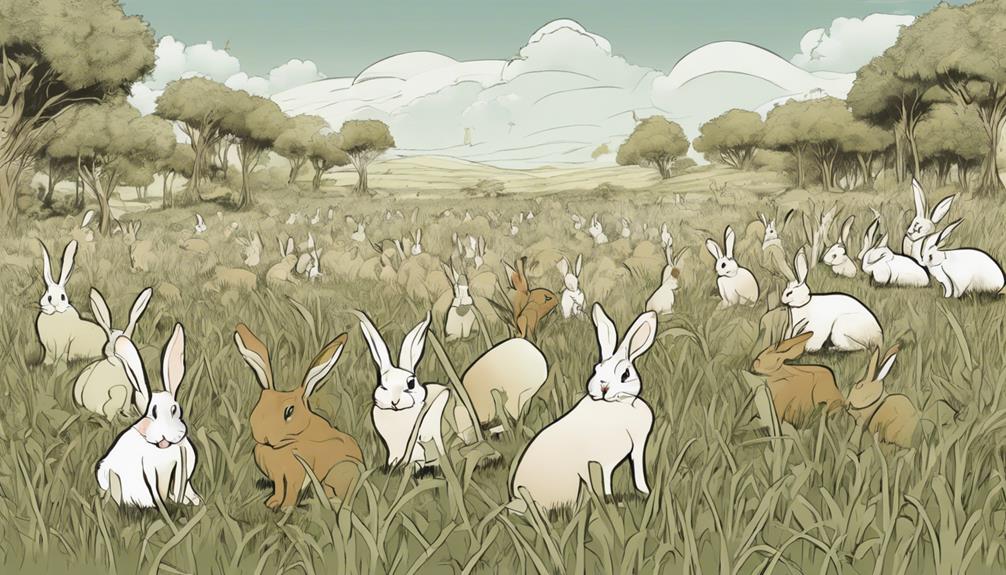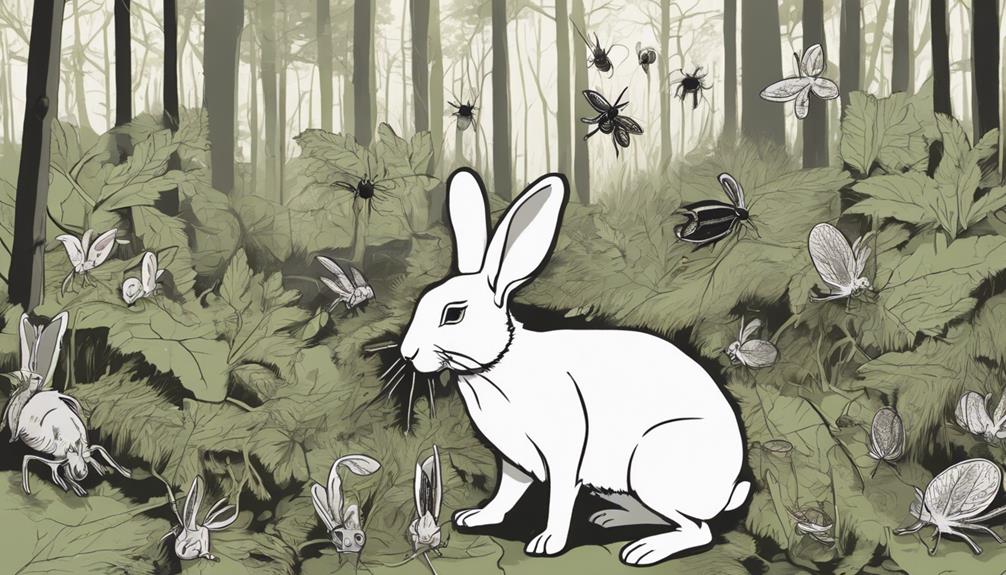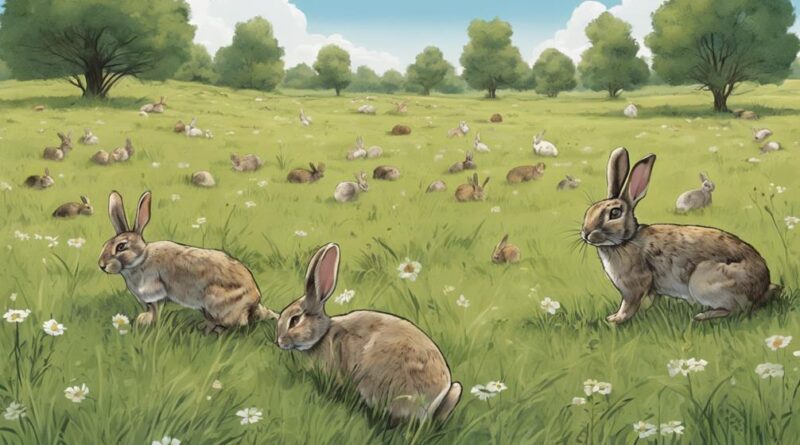10 Tips: Rabbits' Role in Ecosystem Balance Disruption
Rabbits impact ecosystem balance by reproducing quickly, altering plant communities through grazing, and competing with native species for resources. Their burrowing habits can disrupt vegetation and soil health, leading to erosion. Additionally, they can transmit diseases to wildlife and humans, posing risks to ecosystem health. To manage their population, targeted culling and habitat restoration are effective strategies. Understanding the complexities of rabbit behavior and their interactions within the ecosystem is crucial for maintaining biodiversity and ecosystem stability. Curious to explore further insights into rabbits' multifaceted role in disrupting ecosystem balance?
Rabbits' Reproductive Prowess
Rabbits exhibit remarkable reproductive prowess, contributing significantly to their population growth and distribution within ecosystems. Their ability to reproduce rapidly allows them to adapt to various environments and ensures the survival of their species. This reproductive advantage, however, can lead to challenges in population control within ecosystems.
Rabbits have short gestation periods and can produce multiple litters in a single breeding season. Their reproductive cycles are closely linked to environmental factors such as food availability and daylight length. This adaptability enables them to breed throughout the year, resulting in a continuous increase in their population size.
The high reproductive rate of rabbits can have both positive and negative effects on ecosystems. On one hand, it ensures their species' survival and genetic diversity. On the other hand, it can lead to overpopulation, causing competition for resources and habitat degradation. These factors can disrupt the balance within ecosystems and impact other species that rely on similar resources.
Understanding the reproductive dynamics of rabbits is essential for effective population management strategies. By monitoring their reproductive cycles and population trends, conservationists and wildlife managers can implement measures to control rabbit populations when necessary. This proactive approach is crucial for maintaining ecosystem balance and preserving biodiversity.
Impact on Vegetation Growth
The impact of rabbits on vegetation growth is a crucial aspect of understanding their role in ecosystem dynamics. Rabbits, through their grazing effects and browsing behavior, play a significant role in shaping plant communities in their habitats. Grazing by rabbits involves the consumption of grasses, herbs, and other vegetation at ground level, affecting the structure and composition of plant species in an ecosystem. This can lead to changes in plant diversity, with certain species outcompeting others due to selective grazing preferences of rabbits.
Moreover, rabbits exhibit browsing behavior, which involves feeding on woody plants, shrubs, and tree seedlings. This behavior can have long-term impacts on the growth and regeneration of woody vegetation, influencing the overall plant succession patterns in an area. By selectively consuming certain plant species over others, rabbits can alter the balance of vegetation communities and potentially impact the stability of the ecosystem.
Understanding the grazing effects and browsing behavior of rabbits is essential for assessing their overall impact on vegetation growth and ecosystem dynamics. Researchers continue to study how rabbit populations interact with plant communities to better manage and conserve ecosystems where rabbits are present. By considering the role of rabbits in vegetation dynamics, conservation efforts can be more effectively targeted to maintain biodiversity and ecosystem balance.
Predation Pressure on Plants
Predation pressure on plants can result from the grazing and browsing activities of herbivores like rabbits, impacting the overall vegetation dynamics within an ecosystem. Herbivore impact plays a crucial role in shaping plant communities by directly affecting plant consumption. Rabbits, as primary consumers, exert significant pressure on plant populations through their feeding habits, which can lead to alterations in plant distribution and abundance.
The impact of herbivores such as rabbits on plant consumption is multifaceted. These animals feed on a variety of plant species, with preferences for certain plants over others. This selective feeding behavior can influence the composition of plant communities, favoring the growth of some species while suppressing others. As a result, the overall structure of the vegetation within an ecosystem may be altered, affecting the diversity and abundance of plant species.
Plant consumption by herbivores like rabbits can also have cascading effects on other trophic levels within the ecosystem. Changes in plant communities can impact the availability of food and habitat for other organisms, potentially leading to shifts in the abundance and distribution of species at higher trophic levels. Therefore, understanding the herbivore impact on plant consumption is essential for predicting and managing ecosystem dynamics in the face of environmental disturbances.
Competition With Native Species
Frequently, native species face competition from rabbits within the ecosystem, impacting the balance of species interactions. This competition can lead to significant biodiversity impacts and resource depletion. When rabbits compete with native species for resources such as food and habitat, it can result in a decrease in the variety and abundance of other species in the area. This not only affects the native species directly involved in the competition but also has cascading effects on the entire ecosystem.
The ecological imbalance caused by competition with rabbits can also disrupt population control mechanisms of native species. As rabbits consume resources that would otherwise support native species, it can lead to population declines and even local extinctions. This disruption in population dynamics can have far-reaching consequences on the ecosystem's overall health and functioning.
To address the competition with native species, it's crucial to implement management strategies that aim to control rabbit populations effectively. By reducing rabbit numbers through methods such as habitat modification or targeted culls, the pressure on native species can be alleviated, allowing for a more balanced ecosystem where species interactions can occur harmoniously. Managing competition with rabbits is essential for maintaining the stability and resilience of ecosystems and preserving biodiversity.
Soil Erosion Consequences
Significant consequences result from soil erosion within ecosystems due to the disruption of crucial habitats and nutrient cycles. Soil erosion, exacerbated by factors such as rabbit overgrazing, leads to a decrease in soil health. As rabbits consume vegetation, the protective cover that plants provide against erosion diminishes, making the soil more susceptible to being washed or blown away. This erosion not only removes the topsoil where essential nutrients are found but also disrupts the intricate balance of the ecosystem.
A direct implication of soil erosion is the degradation of agricultural lands. Farmers rely on fertile soil to grow crops, but erosion strips away this valuable resource. As soil health deteriorates, agricultural productivity decreases, affecting food production and economic stability. To mitigate these effects, erosion control techniques such as terracing, contour plowing, and planting cover crops are implemented. These methods help prevent soil erosion, maintain soil health, and sustain agricultural practices.
Moreover, land degradation caused by soil erosion can lead to broader ecological consequences. Habitats are altered, affecting the biodiversity of an area. Native plant species may struggle to thrive in eroded environments, leading to shifts in plant communities and potentially impacting other organisms dependent on these plants. Ultimately, soil erosion resulting from factors like excessive rabbit populations can have far-reaching implications beyond the immediate loss of soil.
Altered Food Web Dynamics
The alteration of food web dynamics within an ecosystem can be attributed to changes in species interactions resulting from environmental disturbances like soil erosion. When soil erosion occurs due to factors like overgrazing by rabbits, it can lead to a domino effect impacting various trophic levels within the ecosystem. Trophic cascades, where changes in the population of one species affect multiple trophic levels, often ensue in response to disruptions in food web dynamics.
Such alterations can trigger shifts in population dynamics, causing fluctuations in species abundance and distribution. Biodiversity loss may occur as certain species are disproportionately affected by the changes, potentially leading to a less resilient ecosystem. As the delicate balance of predator-prey relationships is disrupted, the consequences reverberate throughout the food web, influencing the overall health and stability of the ecosystem.
Understanding the interconnectedness of species within a food web is crucial for predicting and mitigating the effects of altered dynamics. By studying population dynamics and trophic interactions, researchers can gain insights into the intricate relationships that govern ecosystem functioning. Ultimately, preserving biodiversity and promoting ecosystem resilience are essential goals in maintaining the delicate balance of food web dynamics in the face of environmental disturbances like soil erosion.
Indirect Effects on Predators

Rabbits' impact on the food web dynamics can indirectly affect predators through alterations in prey availability and distribution. Changes in rabbit populations can cause ripple effects throughout the ecosystem, influencing the abundance and behavior of predator species. A decline in rabbit numbers, for instance, may lead to food scarcity for predators that rely heavily on rabbits as a primary food source. This can result in a decrease in predator population due to insufficient food resources, potentially disrupting the balance within the predator-prey relationship.
The concept of trophic cascades comes into play when discussing the indirect effects of rabbits on predators. A trophic cascade is a phenomenon where changes in the population of one species can impact multiple trophic levels within an ecosystem. In this case, fluctuations in rabbit populations can trigger a trophic cascade that affects the abundance and behavior of predators. For example, a decrease in rabbit numbers could lead to increased competition among predators for alternative prey species, further influencing predator population dynamics.
Understanding the indirect effects of rabbits on predator populations is crucial for assessing the overall health and stability of ecosystems. By recognizing the intricate connections between different species within a food web, conservation efforts can be better informed to mitigate potential disruptions caused by fluctuations in rabbit populations.
Habitat Modification by Rabbits
Habitat modification by rabbits alters vegetation structure and composition, impacting ecosystem dynamics. Rabbits are known to create extensive burrow networks, which can have significant implications for the environment. These burrows not only provide shelter for rabbits but also serve as homes for other species such as snakes, insects, and small mammals. The creation of burrow networks can lead to soil erosion and destabilization, affecting plant growth and water retention in the area.
Moreover, rabbits are selective grazers and can have a profound impact on vegetation through their grazing patterns. By consuming specific plant species over others, rabbits can alter the composition of plant communities, leading to changes in biodiversity and ecosystem function. Areas heavily impacted by rabbit grazing may experience a shift towards less preferred plant species, which can have cascading effects on other organisms dependent on the original vegetation.
Disease Transmission Concerns

With their role in ecosystem balance disruption, rabbits raise concerns about the transmission of diseases within the environment. Rabbits can act as vectors for various diseases, contributing to the spread of pathogens that can impact both wildlife and human populations.
Here are some key points to consider regarding disease transmission concerns related to rabbits:
- Increased Disease Spread: Rabbits can harbor and transmit diseases such as tularemia, myxomatosis, and viral hemorrhagic disease. These diseases can have significant impacts on other wildlife species, domestic animals, and even humans, highlighting the potential for ecosystem disruption.
- Ecological Imbalance: The transmission of diseases by rabbits can lead to imbalances within ecosystems. As certain species are affected by these diseases, it can disrupt food webs, alter population dynamics, and ultimately impact the overall health of the ecosystem.
- Human Health Risks: Rabbits can also pose risks to human health through disease transmission. Direct contact with infected rabbits or their feces can result in zoonotic infections, emphasizing the interconnectedness between wildlife health, ecosystem stability, and human well-being.
Understanding the implications of disease spread by rabbits is essential for managing ecosystem health and preventing potential outbreaks that could have far-reaching consequences. By addressing disease transmission concerns, proactive measures can be taken to mitigate risks and promote a more resilient and balanced environment.
Mitigation Strategies for Rabbits
Implementing targeted culling programs can effectively reduce rabbit populations and mitigate their impact on ecosystem health. Habitat restoration plays a crucial role in mitigating the ecological disruptions caused by rabbits. By restoring native vegetation and creating diverse habitats, ecosystems can become more resilient to rabbit overgrazing. This restoration process helps in providing food and shelter to a variety of species, reducing the reliance on resources that rabbits typically consume.
Population control is another key strategy in managing rabbit populations and their impact on ecosystems. Implementing fertility control methods, such as immunocontraception, can help regulate rabbit populations in a humane and sustainable manner. By reducing rabbit reproduction rates, the overall population size can be managed effectively without resorting to more drastic measures.
Additionally, implementing exclusion fencing in sensitive areas can help protect vegetation from rabbit overgrazing. By limiting rabbit access to certain habitats, the vegetation within those areas can recover and thrive, promoting overall ecosystem health.
Frequently Asked Questions
How Do Rabbits Impact the Water Cycle in Ecosystems?
Rabbits impact the water cycle in ecosystems by altering soil erosion, runoff, groundwater recharge, and evapotranspiration. Their grazing activities can lead to reduced vegetation cover, which in turn increases soil erosion and runoff, affecting the water cycle dynamics.
Furthermore, changes in vegetation patterns caused by rabbits can influence groundwater recharge rates and evapotranspiration processes, ultimately impacting the overall water availability and balance within the ecosystem.
Can Rabbits Contribute to the Spread of Invasive Plant Species?
Rabbits can contribute to the spread of invasive plant species through seed dispersal and competition. They consume various vegetation, altering plant composition and providing opportunities for invasive plants to thrive.
Additionally, their foraging behavior can lead to soil erosion, further aiding the establishment of invasive species.
Do Rabbits Affect the Availability of Nesting Sites for Birds?
Rabbits can impact bird populations by competing for habitat space, affecting nesting site availability. This habitat competition can lead to a decrease in biodiversity as birds may struggle to find suitable areas to build nests.
Additionally, rabbits are known to engage in nest predation, which can further impact bird population dynamics. Understanding these interactions is crucial for managing ecosystems and promoting the coexistence of different species.
Are There Any Cultural Implications of Rabbits' Overpopulation?
In terms of cultural significance, rabbits' overpopulation can have various consequences. These furry creatures, when their numbers surge, may impact agricultural practices, leading to crop damage and resource competition.
Additionally, in certain cultures, rabbits hold symbolic meanings, and an overabundance could alter these symbolic associations.
It's essential to consider not only the ecological but also the cultural implications of managing rabbit populations to ensure a balanced ecosystem and respect for cultural traditions.
What Role Do Rabbits Play in the Nutrient Cycling of Ecosystems?
In ecosystems, rabbits play a crucial role in nutrient cycling by grazing on plants, which helps in decomposition and nutrient release into the soil. This process contributes to soil fertility and supports the growth of diverse plant species, enhancing biodiversity.
However, when rabbit populations become too large, they can overgraze vegetation, disrupting this delicate balance and impacting nutrient cycling, ultimately affecting ecosystem health and stability.
Conclusion
In conclusion, the presence of rabbits in ecosystems can have significant impacts on vegetation growth, predation pressure on plants, competition with native species, soil erosion, predator populations, habitat modification, and disease transmission.
Understanding the role of rabbits in ecosystem balance disruption is crucial for implementing effective mitigation strategies to maintain ecological stability.
By addressing these factors, we can better manage rabbit populations and minimize their negative effects on the environment.
